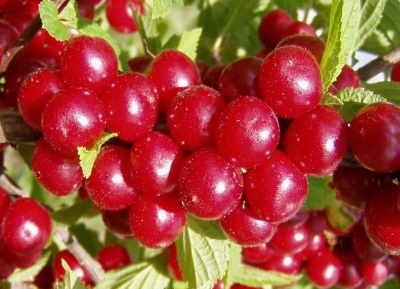
- Authors: G. T. Kazmin (DalNIISH)
- Year of approval: 1965
- Barrel type: bush
- Growth type: vigorous
- Escapes: straight, thick, grayish-brownish, with noticeable pubescence
- Leaves: ovate, hard, with rather strong pubescence
- Flowers: large, pale pinkish
- Flowering and fruiting type: mixed - at the ends of annual shoots and shortened bouquet branches
- Fruit size: large or very large
- Fruit size, mm: height 1.6 cm, diameter 1.8 cm
Experienced summer residents, choosing a variety for planting, often look closely at felt types of cherries, which are characterized by completely simple agricultural techniques and quick adaptation to climatic conditions. A striking representative of the felt species is the cherry variety Leto with a long history.
Breeding history
Cherry Leto appeared in the Far Eastern Research Institute of Agriculture in 1955. The author of this variety is the scientist A.G. Kazmin. The variety was obtained as a result of free pollination of sand cherry. That is why Summer has the characteristics of both felt crops and sandy ones. Fruit and berry culture was added to the State Register of Breeding Achievements in 1965. Felt cherry is recommended for cultivation in the Khabarovsk and Primorsky regions.
Description of the variety
Cherry summer is a bushy, vigorous plant, characterized by compact, upright skeletal branches of gray-brown color, moderate thickening of emerald-green foliage with pronounced pubescence and miniature red-brown buds tightly attached to the shoots. In a favorable environment, the bush stretches up to 150 cm in height. Mixed ovaries are formed on short bouquet twigs and annual shoots. A characteristic feature of the variety is the pronounced roughness of the bark. For the first few years, the growth of the culture is slow, but over time, the rate will return to normal.
Cherry blossoms begin in the last week of May (June 25th to 6th). At this time, the bush is abundantly covered with large pale pink flowers with unusual oval petals. Due to such beauty during the flowering period, the cherry tree is considered an ornamental fruit tree, capable of decorating any garden.
Fruit characteristics
Summer is a representative of large-fruited varieties. The shape of the berries is non-standard - round-cylindrical. The lateral slope gives the cherry this shape. On average, the weight of the fruit is 3.3 grams. At the stage of technical maturity, the cherry has a light pink color. Ripe berries are unevenly colored in pale red. The peel of the berries is quite dense, with a pronounced edge of the surface, complemented by a beautiful gloss. The abdominal suture on the surface is very prominent. The stalk of cherries is shortened, it comes off partially with the pulp, so the harvest does not tolerate transportation well, and is stored for no more than 4 days.
The purpose of table cherries is that they are used in cooking, eaten fresh, canned, processed and frozen.
Taste qualities
The cherry variety Leto has good taste and good commercial qualities. The pale pink flesh is endowed with a fleshy, tender, thick and juicy texture. The berries have a harmonious taste - sweetish, with a piquant sourness and barely noticeable freshness. Light pink juice is characterized by a rich consistency with a slight sweetness. Cherry pulp contains 9% sugars and less than 1% acids. The small bone is easily separated from the pulp.
Ripening and fruiting
Felt cherry Leto belongs to the group of berries with medium ripening times.The tree bears fruit from the 2nd year after planting. The berries begin to sing massively at the end of July. Ripe cherries do not crumble, and can hang on the tree until the 20th of August. Ripening of berries is amicable. The tree bears fruit steadily - every year. The tree has a lifespan of 10 to 20 years.

Yield
Yield indicators for Summer cherry are average. Usually, up to 7.8 kg of berries can be harvested from an adult cherry bush tree.
Growing regions
In the last decade, the variety has gained popularity, expanding the geography of growth - Central Black Earth, Far Eastern, Ural, North Caucasian, Volgo-Vyatka and many other regions.
Landing
The best time for planting a cherry seedling is considered early spring - before bud break. The seedling should be bought one to two years old, 100-120 cm high. The distance between trees should be 2-3 meters.


Growing and caring
It is recommended to grow in a cleared area, located on a small hill, well-lit by the sun, and also protected from drafts. Cherry and cherry-plum-column will be good neighbors for cherries.
Crop care consists of regular watering, controlling moisture, fertilizing, tilling the soil, removing dry branches, preventing disease, mulching using agrofibre, burlap or straw.


Disease and pest resistance
The variety has high immunity, so cherries rarely undergo coccomycosis and moniliosis.
Requirements for soil and climatic conditions
Cherry variety Summer is characterized by moderate frost resistance, and can also easily tolerate short-term drought. Sandy and sandy soil with the following characteristics is considered optimal for the comfortable growth of cherries - highly fertile, breathable, moisturized, with deep groundwater.
































































